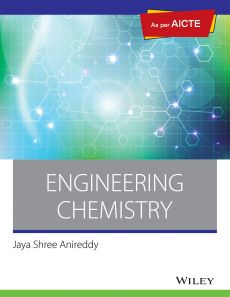Engineering Chemistry, As per AICTE
ISBN: 9788126504473
608 pages
eBook also available for institutional users
For more information write to us at: acadmktg@wiley.com

Description
The objective of Engineering Chemistry is to build a solid foundation in fundamentals of chemistry and an interface of theoretical concepts with their industrial/engineering applications. This book is designed as an introductory course in Engineering Chemistry with complete coverage as per new AICTE curriculum. It aims to impart students an in-depth knowledge of various aspects of chemistry as applied to engineering. The content has been compiled after detailed analysis of the latest AICTE syllabus. The lucid explanation of the topics will help students understand the fundamental concepts and apply them to solve the problems. An attempt has been made to logically correlate topics with their applications.
Preface
About the Author
1. Atomic and Molecular Structure
Learning Objectives
Atomic Structure
1.1 Atomic Model– from Classical Mechanics to Quantum Mechanics
1.2 The Schrödinger Equation
1.3 Particle in One-Dimensional Box
1.4 Particle in Three-Dimensional Box
1.5 Wavefunctions and Probability Densities of Hydrogen and Hydrogen-Like Atoms
Molecular Structure
1.6 Valence Bond Theory
1.7 Molecular Orbital Theory
1.8 Theories for Bonding in Coordination Compounds
1.9 Crystal Field Theory
1.10 Coordination Number and Geometry
1.11 Magnetic Properties of the Transition Metal Complexes
1.12 Metallic Bond
2 Periodic Properties of Elements
2.1 Effective Nuclear Charge
2.2 Penetration of Orbitals
2.3 Orbital Energies
2.4 Electronic Configuration of an Atom
2.5 Modern Periodic Law and Periodic Table
2.6 Periodic Trends in Properties
2.7 Acid-Base Chemistry
3. Intermolecular Forces and Potential Energy Surfaces
3.1 Intermolecular Forces
3.2 Ionic Interactions
3.3 Dipolar Interactions
3.4 van der Waals Interactions
3.5 Equations of State of Real Gases
3.6 Potential Energy Surfaces
4. Thermodynamics
4.1 Some Important Terms in Thermodynamics
4.2 The First Law of Thermodynamics
4.3 Enthalpy or Heat Content
4.4 Thermochemistry
4.5 The Second Law of Thermodynamics
4.6 Entropy
4.7 Free Energy
4.8 Maxwell Relations
4.9 Thermodynamic Criteria for Equilibrium
4.10 Ionic Equilibrium
4.11 Application of Thermodynamic Principles in Electrochemistry
4.12 Application of Thermodynamic Principles in Metallurgy
5. Corrosion
5.1 Corrosion in Metals and Alloys
5.2 Corrosion Cell
5.3 Theories of Corrosion
5.4 Types of Electrochemical Corrosion
5.5 Other Types of Corrosion
5.6 Factors Influencing Rate of Corrosion
5.7 Corrosion Control Methods
5.8 Protective Coatings
5.9 Metal Finishing
5.10 Electroplating Process
5.11 Surface Preparation for Coating
5.12 Electroplating of Chromium and Silver
5.13 Electroless Plating
6. Water Techonolgy
6.1 Sources of Water
6.2 Impurities in Water
6.3 Hardness of Water
6.4 Determination of Hardness of Water
6.5 Disadvantages of Hard Water
6.6 Alkalinity of Water
6.7 Analysis of Water
6.8 Water Quality Parameters
6.9 Municipal Water
6.10 Treatment of Water for Domestic Purposes
6.11 Boiler Feed Water
6.12 Techniques for Water Softening
6.13 Wastewater
7. Reaction Mechanism and Synthesis of Drug Molecules
Organic Reaction Mechanisms
7.1 Bonding in Organic Molecules
7.2 Electronic Displacement Effects in Organic Molecules
7.3 Reactive Intermediates
7.4 Attacking Reagents in an Organic Reaction
7.5 Types of Organic Reactions
7.6 Substitution Reactions
7.7 Addition Reactions
7.8 Elimination Reactions
7.9 Oxidation Reactions
7.10 Reduction Reactions of Carbonyl Compounds
7.11 Hydroboration of Olefins
7.12 Cyclization Reactions
7.13 Ring Opening Reactions
Structure, Synthesis and Applications of Drug Molecules
7.14 Paracetamol
7.15 Aspirin
8. Stereochemistry Learning Objectives
8.1 Isomerism
8.2 Three-Dimensional Representation of Structures
8.3 Newman Projections
8.4 Chirality and Optical Activity
8.5 Optical Isomerism
8.6 Configuration
8.7 Geometrical Isomerism
8.8 Conformational Isomerism
8.9 Isomerism in Transition Metal Compounds
9. Spectroscopy Learning Objectives
9.1 Electromagnetic Radiation
9.2 Molecular Spectroscopy
9.3 Basic Spectroscopy Instrumentation
9.4 Infrared Spectroscopy
9.5 NMR Spectroscopy
9.6 UV–Visible Spectroscopy
9.7 Fluorescence and its Applications to Medicine
9.8 Surface Characterization Techniques
9.9 Diffraction and Scattering
Key Terms
Objective-Type Questions
Review Questions
Numerical Problems
Answers
Experiments
Index

